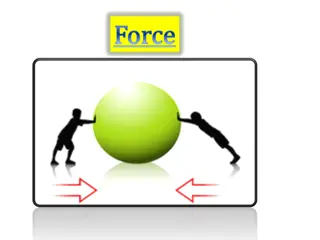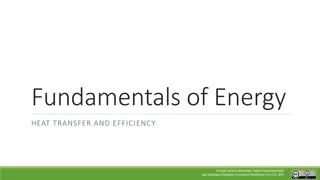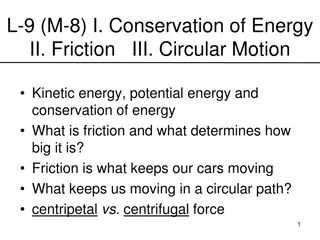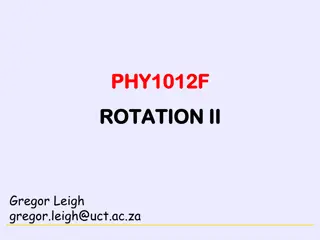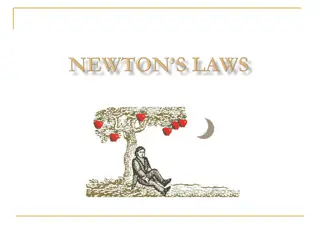Conservation of Energy in Forces and Potential Functions
In today's section, the concepts of work, energy conservation, gravitational potential, and conservative/non-conservative forces are discussed. It delves into the real terms introduced for these concepts, unconventional variable usage, and differentiation between conservative and non-conservative forces. The inclusion of gravitational potential in the work term is highlighted, along with examples of conservative forces like weight and spring work. The calculation of kinetic and gravitational potential energy is explained, emphasizing the algebraic representation of potential functions. The conservation of energy in systems acted upon by both conservative and non-conservative forces is also addressed, with practical problem-solving applications.
Download Presentation

Please find below an Image/Link to download the presentation.
The content on the website is provided AS IS for your information and personal use only. It may not be sold, licensed, or shared on other websites without obtaining consent from the author.If you encounter any issues during the download, it is possible that the publisher has removed the file from their server.
You are allowed to download the files provided on this website for personal or commercial use, subject to the condition that they are used lawfully. All files are the property of their respective owners.
The content on the website is provided AS IS for your information and personal use only. It may not be sold, licensed, or shared on other websites without obtaining consent from the author.
E N D
Presentation Transcript
Summary Work (Force dot distance) and Energy Conservation After including gravitational potential in the work term, in todays section they introduce real terms for it. The variables used are also unconventional. Kinetic Energy = T Gravitational Potential Energy = V Work = U Textbook differentiates Conservative and Non-Conservative forces. Conservative independent of path (PE and KE) Non-Conservative depends on path (Work, friction work)
14.5 Conservative Forces and Potential Energy Conservative Force If the work of a force is independent of the path and depends only on the forces initial and final positions on the path, then we can classify this force as a conservative force. Examples include work of a weight and work of a spring. An examples of a non-conservative force is the work of friction (the longer the path, the more friction). Energy Energy is defined as the capacity for doing work. Kinetic energy is equal to the work that must be done on a particle to bring from a rest to a specific speed. Gravitational Potential Energy If a particle is located a distance above an arbitrarily selected datum. The particle s weight has a positive gravitational potential energy. = EQ 14-13 V Wy g
14.5 Conservative Forces and Potential Energy Elastic Potential Energy The potential energy of a displaced spring is given as: ??= +1 2??2 EQ 14 14 Potential Function When a particle is subjected to both gravitational and elastic forces, the particles potential energy can be expressed as a potential function, which the algebraic sum: ? = ??+ ?? EQ 14 15 For example, the potential function for a weight suspend from a spring is: V V = = + V + g Ws e 1 2 ks 2
14.6 Conservation of Energy Conservation of Energy When a particle is acted upon by a system of both conservative and non-conservative forces, the portion of work done by the conservative forces can be written in terms of the difference in their potential energies, thus: ( ) T V + + = + U T V 1 2 1 1 2 2 noncons. Conservation of Energy (conservative systems) If only conservative forces act on the system: T V + = + 2 V EQ 14-21 T 1 1 2 Conservation of Energy for a System of Particles (conservative systems) The conservation of energy equation can be extended to a system of particles: + = + 2 E Q 14 22 - T V T V 1 1 2
In-Class Practice Problem 1 Use Energy Conservation to find vbottom Knowing the velocity, use n-t to find acceleration Use EoM to calculate tension in cable Sum forces in y to find forces in posts
In-Class Practice Problem 2 Solving two problems same method Use n-t to find velocity necessary for car to stay on tracks while inverted. Back-solve for height necessary to ensure those velocities. Can choose any datum you want .just be consistent.
In-Class Practice Problem 3 Problems like this are almost too easy using conservation of energy. State 1 is h = 0, but includes elastic potential energy of stretched springs State 2 is h = 0.5 m and includes Ve and Vg terms. Use right triangle to determine the length the spring is stretched. Follow-up Questions What happens after the mass is at the bottom? Can you calculate the force in each spring as a function of height? Can you apply EoM to find the acceleration of the mass at any given height?










